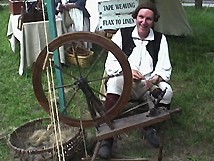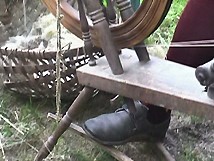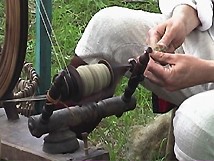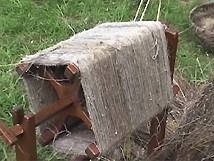*SPINNING & FIBERS*
FIBERS FOR SPINNING
Fibers used for spinning in America are listed
below:
| FIBER TYPE
& SOURCE |
FABRIC /
USE |
CHARACTERISTICS |
| Flax plant |
linen |
- durable due to long fibers
- will not shrink
|
| Sheep's wool |
wool |
- durable, warm, fire resistant
- easy to dye
- continues to shrink with use and water
|
| Cotton plant |
cotton |
- soft, comfortable easily dyed
|
| Hemp plant |
hemp rope and
sacks, some fabric |
|
| Silk (uncommon
in America) |
silk |
|
SPINNING PROCESS
To prepare for the making of fabric, fibers
are twisted to make yarn. The simplest method uses fibers held
between the fingers which are spun on a drop spindle; this method
was used through the 1700's. Spindle type wheels were introduced
from the Orient to Europe in the middle ages.
The process shown below uses flax and a flyer-type
spinning wheel.
 |
|
 |
| This spinning wheel is a flyer-type
spinning wheel. |
|
The spinster uses a foot
pedal to move the flywheel. A string connected to the pedal pulls the
flywheel on its circular path. |
 |
|
 |
| The fiber passed through
a groove on the tip of the spindle which held it while the person spinning
the fiber drew out the yarn. |
|
Yarn was wound into loose
skeins and measured using a variety of tools. After dying, the yarn was
ready for weaving. |



